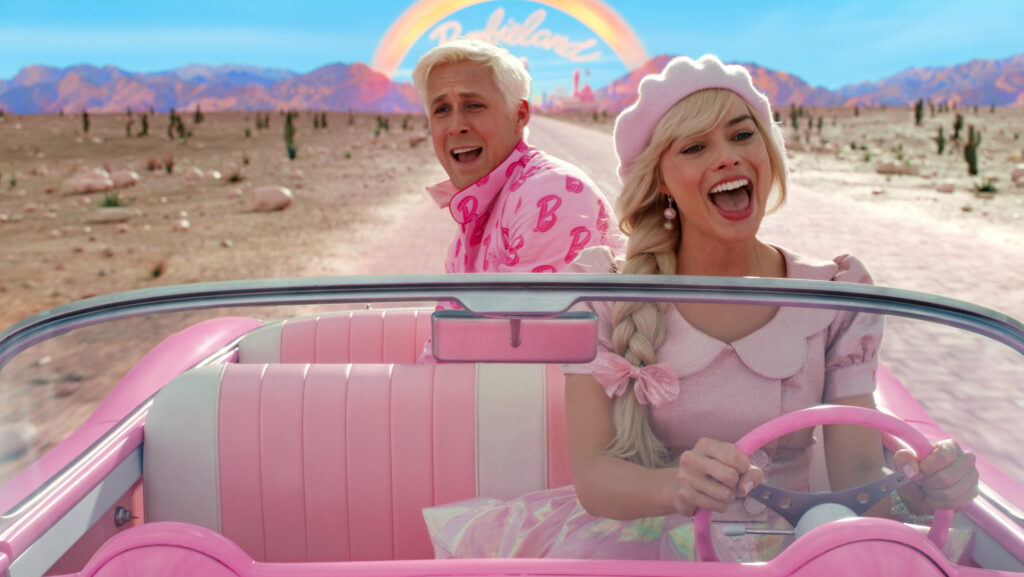by Kaya Sights
Note: This review contains spoilers for Barbie (2023).

Beneath its surface as a lighthearted and fun film, Barbie unexpectedly engages in a comical, self-aware dialogue on existentialism, consumerism, and patriarchy with its audience of young girls. Director Greta Gerwig redefines Mattel’s Barbie doll through this cinematic interpretation of one of the world’s most beloved toy franchises. Audiences follow Margot Robbie as the “Stereotypical Barbie” alongside Ryan Gosling’s Ken and their lives in the seemingly perfect pink paradise known as Barbieland: a utopian world governed by the Barbies, completely devoid of misogyny, where they all occupy prestigious positions within traditionally male-dominated sectors. The Barbies and Kens (and Allan) live in total ignorance of real-world issues, believing that the creation of the Barbie doll single-handedly abolished gender inequality.
The main conflict of the story arises once it is revealed that the condition of a Barbie in Barbieland reflects how she is being “played with” by her real-world owner. After Barbie begins experiencing sudden thoughts of death and the distressing emergence of cellulite, she ventures to Los Angeles, desperate to maintain her image as the stereotypical perfect Barbie. She frantically searches for her owner’s identity, only to find out society is not at all what it seems.
Within minutes of being in LA, Barbie gets catcalled by a group of men at the beach. Puzzled by this unwanted attention, she asks, “Why are these men looking at me?” to which Ken proudly replies, “They’re also staring at me!” Whereas Ken appears to be enjoying himself, Barbie expresses her self-consciousness, an entirely foreign feeling for her. This scene demonstrates the juxtaposition between how she is treated in Barbieland versus the real world: no longer on a pedestal with Kens in her shadow, the reversal of roles that Barbie experiences shatters the illusion of a perfectly equal society, mirroring the unjust dynamics of the real world.
Shortly after, she gets molested by a passerby and punches him in self-defense, landing her and Ken in prison. The police officers make a series of inappropriate comments about her clothing, and as these uncomfortable encounters pile up, she slowly but surely realizes that the creation of the Barbie doll wasn’t as progressive as she once believed.
An issue arises here. That as discussions on feminism and gender inequality are sparked through these scenes, an obvious lack of nuance is clear. Despite casting a handful of non-white actors, their characters do not play an integral role in the storyline aside from serving as props to the plot and protagonist. The story is only told from the lens of a white woman and completely fails to address the distinct struggles faced by women of color (WOC). An example of this would be President Barbie, portrayed by Issa Rae. Despite holding a high-ranking position in Barbieland, there was a great lack of discussion of her character’s personal experience as a Black woman. A dive into her journey of attaining political authority as a woman of color would’ve been an interesting addition to the overall plot, shedding light on the challenges WOC face in white-dominated industries. While the film persistently strives to depict the struggles and liberation of women, it’s important to ask: What kind of woman?
This issue of overlooking intersectionality is present throughout Gerwig’s filmography, as seen in works such as Lady Bird (2017) and Little Women (2019). These films were widely acclaimed as feminist masterpieces despite their predominantly white-centered narratives. Barbie missed the opportunity to delve into the WOC experience and how it greatly differs from a white woman’s, which would have added more depth to the film’s exploration of feminism. Overall, the execution of its message seems superficial: the film more closely resembles a plastic politics-infused toy commercial for white girls at times than an accurate medium of representation of all women.

On the other hand, what I believe Barbie does right is address the issue of internalized misogyny and its subtle manifestation in our subconscious. Misogyny isn’t just hate towards women, but also deeply ingrained prejudices—something people tend to forget when considering and advocating for feminism. Sasha, Barbie’s presumed owner, says: “Everyone hates women; men hate women and women hate women. It’s the only thing we can all agree on.” The connection between internalized misogyny and patriarchy is a symbiotic one, each reinforcing the other in a cycle of oppression. Patriarchy as a systemic structure assigns power to men whilst subordinating women: implementing harmful stereotypes, dictating traditional gender roles, and marking anyone who does not follow these roles as targets for violence. In this environment, women are conditioned to conform to these roles to avoid being discriminated against, leading to the internalization of sexist beliefs and attitudes. As long as the patriarchy exists, it provides the fertile ground on which internalized misogyny thrives, in turn reinforcing patriarchal norms. This is touched on in more depth when Gloria, Barbie’s real owner, delivers a profound monologue about the struggles of living as a woman in modern-day society.
Gloria’s monologue was not at all subtle in its delivery, coming across as slightly “in-your-face”, yet I still resonated deeply with it. As America Ferrera, Gloria’s actress, told the Los Angeles Times: “There’s no woman in my life who those words aren’t true for.” Just hearing someone discuss the constant burden of contradictory expectations struck a chord with me, despite the flaws of its execution. She discusses themes of body image, motherhood, and career ambitions, underscoring the daily challenges women confront in a seemingly never-ending struggle. The overarching message of Gloria’s monologue is that no matter what women do, we will never really be free from society’s scrutiny; this is a result of the patriarchal system intentionally designed to maintain this status quo.
Moreover, the film has garnered lots of controversy for its “misandrist” themes: being labeled as an “assault on men” by Piers Morgan and “woke garbage” by a multitude of right-wing commentators. Much of the controversy stems from the reversal of societal dynamics in Barbieland, where the Barbies are the governors and breadwinners, and the Kens are portrayed as airheads and mere accessories. I believe the aim of this was to illustrate the absurdity of one-dimensional portrayals of women onscreen in both classic and contemporary cinema, yet it was widely interpreted as an attack on men. What most male audiences failed to realize is that women have been subjected to this type of treatment for several decades—it only seemed to catch their attention once a similar treatment was directed back at them, exemplifying the very point of the movie.
While Barbie is undoubtedly a visually stunning and whimsical watch, it is by no means a feminist masterpiece. The film’s shortcomings are mainly the result of its white feminist agenda, and though it is nowhere near perfect due to its limited perspective, it nonetheless provides an accurate depiction of the woes of womanhood. Its messages and themes aren’t necessarily original or groundbreaking, but they are a welcome change from the sexist and misogynistic stereotypes portrayed all too often in Hollywood by male directors, capturing the complexities of the female experience in a way that most women can relate to in some way.